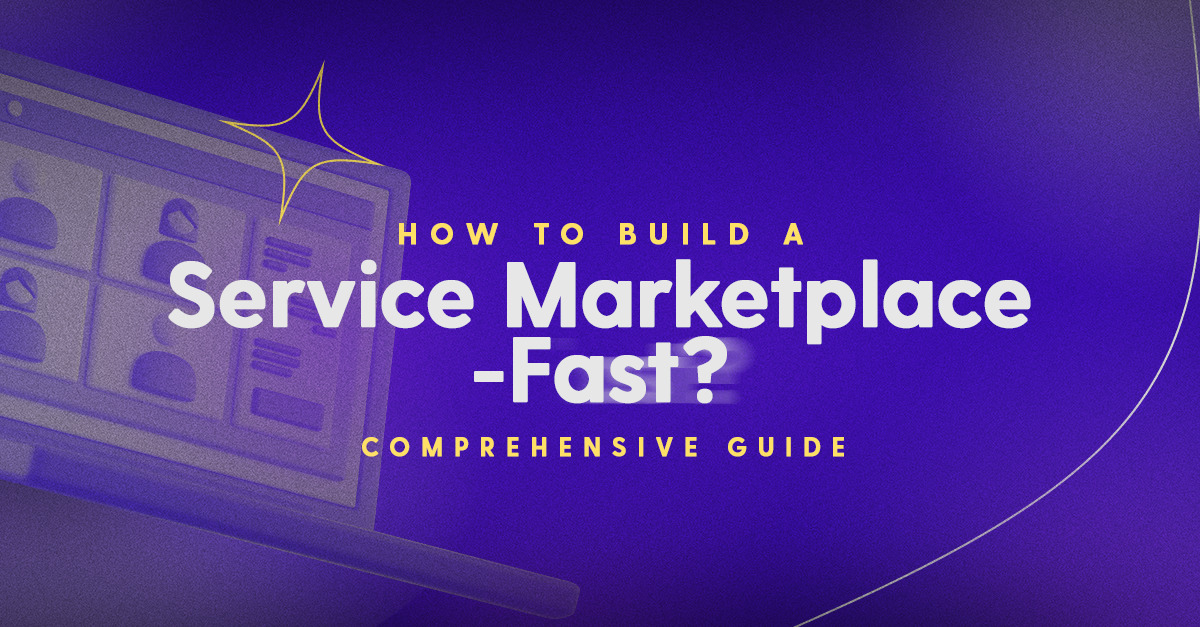With so many options for starting an online business today, it’s sometimes hard to decide what path to choose.
If you’re thinking about starting a business, online service marketplaces like Upwork, Fiverr or Thumbtack are a great option since service marketplaces:
- Tap into a growing trend of gig economies where millions of individuals and businesses worldwide look to hire freelancers in almost every business vertical. There is plenty of opportunity to create a niche service marketplace to outperform existing players who offer more general solutions.
- Are massively scalable. This is because service marketplaces have far lower overheads when compared to traditional service based businesses.
- Benefit from network effects meaning that for every new user that joins, the value of the marketplace increases exponentially.
- Have the potential for significant revenue generation through commission fees, advertising, premium membership fees and other monetization strategies.
In this article, we are going to walk you through a step by step guide to show you how to build a service marketplace. We will explain:
What Is a Service Marketplace?
A service marketplace is an online marketplace that connects service providers with potential customers. Whether it’s freelance platforms like Upwork and Fiverr or local service marketplaces like TaskRabbit and Thumbtack, these platforms allow businesses and individuals to find, hire, and pay service providers seamlessly.
Examples of Popular Service Marketplaces:
- Freelance Marketplaces – Upwork, Fiverr, Toptal
- Local Services Marketplaces – Thumbtack, TaskRabbit, Handy
- Professional Consulting Marketplaces – Catalant, Clarity.fm
- Home Services Marketplaces – Angi (formerly Angie’s List)
Service marketplaces often provide tools for communication, project management and payment processing to facilitate transactions between service providers and clients.
Why service marketplaces are booming:
- The gig economy is projected to reach $455 billion by 2025.
- Consumers increasingly prefer on-demand services over full-time hires.
- High-profit potential through commission-based marketplace models.
How Do Service Marketplace Business Models Work?
There are eight primary marketplace business models. These include:
– Commission Model – Earn a percentage from each transaction (e.g., Fiverr).
– Subscription Model – Charge monthly fees for premium access (e.g., LinkedIn ProFinder).
– Listing Fee Model – Charge service providers to post listings (e.g., Craigslist).
– Lead Fee Model – Charge businesses per lead (e.g., Thumbtack).
– Freemium Model – Offer free access with paid upgrades (e.g., Clarity.fm).
– Ads & Featured Listings – Earn from advertising placements (e.g., Angi).
Most profitable model? The commission model is the most scalable and widely used.
In this article we will focus on the commission model. For a more comprehensive review of the different marketplace business models, read the top marketplace business models.
In the commission model, the marketplace earns revenue by charging a commission, also known as the take rate, rake or transaction fee, when connecting service providers with customers.
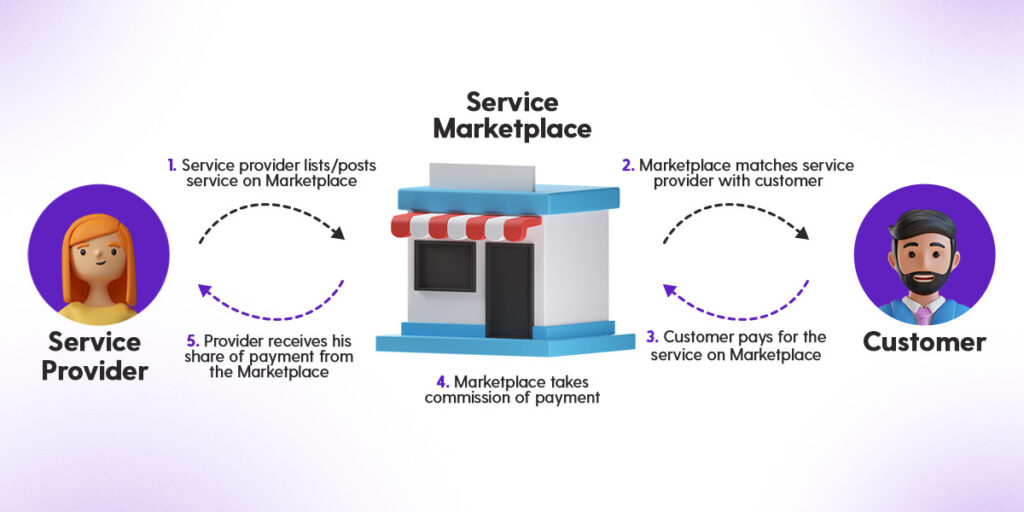
The commission model is especially popular since neither the service provider nor the customer needs to pay a fee to join the marketplace. This can help drive your initial user adoption.
Who and what to charge?
When implementing the commission model, you need to decide who you are going to charge the fee to and how much commission you’re going to charge to that person.
Who to charge?
The commission fee can be charged either to the service marketplace provider, the customer or both. But how do you decide who to charge? Well, consider the quote from Venture Capitalist, Bill Gurley:
Bill Gurley, Venture Capitalist
As you can see, high rakes (or commissions) are a form of friction. You want to therefore charge the commission fee on the side of the market where you are least constrained. For example, if you’re constrained on the supply side, then it is better to charge the demand side. Most service marketplaces are constrained on the customer (demand) side. Therefore, it is preferable to charge the service side of the marketplace.
Let’s take a quick look at how the service marketplace TaskRabbit implemented this model.
TaskRabbit is a platform that connects individuals and businesses with local service providers for various tasks and errands, such as home repairs, cleaning, moving, and handyman services. TaskRabbit charges a commission fee to the service providers (taskers) for each completed task. The commission fee is deducted from the payment received by the tasker for their services. However, TaskRabbit does not charge a commission fee to the clients (those requesting tasks to be completed).
This model incentivizes taskers to join the service marketplace and offer their services without upfront costs, as they only pay a commission when they successfully complete a task and receive payment. Clients, on the other hand, can use the platform to find and hire taskers without incurring any additional fees beyond the agreed-upon task price.
By charging a commission only on the supply side (taskers), TaskRabbit aims to eliminate the friction of clients hiring taskers through their platform, by giving them a cost-effective way to hire local help for their tasks and errands.
How much to charge?
There is no one pricing strategy that works for all service marketplaces. The rate that you can set boils down to the market that you’re after. This is because all markets have different marginal costs, levels of competition, demand and supply differentiation, transaction size and volume and network effects.
Let’s break each of these points down quickly.
Marginal costs
Service providers in different markets have different costs when deploying their services. These costs impact how much profit the service provider can make per unit of service they provide.
For example, consider a hypothetical marketplace as a service that connects tutors with students.
On this service marketplace, a tutor is able to sell their services at $50 per session. However, let’s say that the marginal cost per tutoring session is $20. This includes expenses such as time, transportation, any materials used and so on. In this case, if the tutoring platform charges 20% commission, this means that the tutor will be earning a profit of $20 per session. This probably works out okay for the tutor. However, if the marketplace sets its take rate to 50%, this would mean that the tutor is only earning $5 per session which may not be financially viable. In his case, the tutor may decide that they no longer want to offer their services on the marketplace as as a service not financially viable for them to do so.
Levels of competition
If your online service marketplace is in a space that is heavily competitive, this can make it very difficult to charge high commissions. This is because competitive pressures generally force online service marketplaces to lower their take rates to attract and retain service providers.
Conversely, in a less competitive market where there are fewer alternatives for service providers. Marketplaces may have more flexibility to set higher take rates without fear of losing providers. Overall, competition can drive marketplaces to adjust their take rates in order to remain competitive and attract both providers and customers.
Demand and supply differentiation
Do your service providers and customers differ in the way that they transact on your online service marketplace? For example, do you have some providers and customers who transact large amounts frequently and do you have others that transact smaller amounts less frequently? Do you want to charge them the same amount?
Network effects
Marketplace network effects occur when the value of the platform increases with the number of users, both service providers and customers.
A classic example of how network effects create value is the telephone. Initially, the value of owning a telephone is very limited when there is no one to call. However, as more people acquire telephones the value of each individual telephone increases exponentially. This means that the larger your network effect, the larger commission you can charge.
The value provided by your marketplace
Lastly, you can think about what value you’re providing with your marketplace. Are you just connecting service providers with customers or does your platform provide additional value such as running background checks on service providers, offering additional support or tools to help service providers grow their businesses, do you offer insurance or guarantees to protect customers? All of these factors can influence the perceived value of your online service marketplace and may justify a higher commission rate.
Online service marketplace business models: Final thoughts
Service marketplaces tend to evolve their business models over time. Often the result is a mixed model that combines the commission model with other business models such as featured listing, subscription to premium features and so on.
Nowhere is this more apparent than the service marketplace Thumbtack who continually iterated on their business model until finally settling on a lead fee model. The video from the founder below explains the gradual evolution of their marketplace.
How to build a successful online service marketplace
Even though there are various marketplace as a service software and no-code / low-code platforms, developing a successful online service marketplace is still a challenge. If anyone tells you that it is easy, the chances are that they have not done it.
While there is no formula for success, we recommend taking the following steps in order to develop a successful service marketplace:
Find a Niche
For an online service marketplace to be successful, it must solve a real world problem for both service providers and customers. For instance, the marketplace as a service Upwork enables businesses to find qualified freelancers for specific projects, saving them time and resources in the hiring process. At the same time, Upwork offers freelance professionals the opportunity to showcase their skills, find work and build relationships with clients worldwide.
In order to find an idea for an online service marketplace, you should consider attempting to monetize either an existing community or searching for a new niche marketplace idea. One of the best places to look for marketplace as a service ideas is within passionate or underserved community.
It is also okay to focus on improving on an existing idea. For example, if you’re looking to build a freelancer marketplace, you might want to focus on a new technology or trend such as machine learning and AI, where the existing platforms haven’t got a solution.
So, instead of competing with Upwork or Fiverr, target a specific niche.
Examples of Profitable Service Marketplace Niches:
✔ AI & Machine Learning Experts – An online service marketplace for AI engineers.
✔ Eco-Friendly Home Services – Connect homeowners with green service providers.
✔ Healthcare Consulting Services – A marketplace for remote health consultations.
✔ Legal & Compliance Freelancers – A platform for on-demand legal help.
To learn more, read how to come up with a great idea for an online marketplace.
Validate your idea
Once you have an idea, the next step is to validate that there is a market for the idea. You should do this before investing huge amounts of time and money into the development of your marketplace.
There are five popular steps that marketplace founders often use to validate their idea. These include:
- Testing any risky assumptions that you’re making about your market
- Assessing your market size and share
- Researching search volume for related keywords like “best freelance platforms” or “hire a consultant online”
- Conducting user interviews to identify pain points
- Analyze competitors like Thumbtack, TaskRabbit, or Catalant for gaps
- Building the first version of your marketplace
For more information on how to validate your marketplace idea, read our article, how to validate your marketplace business idea.
Choose your tech stack
Once you’ve validated that your service marketplace idea is viable, the next step is to choose the technology that you’re going to use to build your service marketplace. This will be your “technology stack” or “tech stack”. You can either choose to build your technology from scratch or use specialist marketplace technology to develop your service marketplace.
Developing a marketplace from scratch can cost $100K+. Instead, use can use a pre-built marketplace platform.
Top Marketplace Development Platforms:
– Dittofi – No-code marketplace builder with full scalability & source code export.
– Sharetribe – Fast to launch but limited in customization.
– Bubble.io – No-code but struggles with performance & scalability.
– Custom Development – Maximum flexibility but expensive & slow.
Some key things you need to think about when choosing a tech stack for your service marketplace include flexibility, performance, speed of development, cost of developers and cost of hosting.
Flexibility
As American investor Mark Cuban says, “the only constant in business is change”, therefore it is crucial to choose a flexible tech stack for your service marketplace.
A flexible tech stack will enable your platform to adapt to meet changing business requirements, user needs, and technological advancements. Therefore, ask yourself, do you have complete control and ownership over your entire tech sack? Are you potentially going to be a victim of vendor lock-in?
Speed of development
Good product is rarely built in isolation. Rather it is a collaboration between you and your customers. Therefore, it’s very important to get your product to market fast and then to be able to quickly adjust it for customer feedback.
Specialist no code marketplace technologies can help you launch fast however, these platforms come with limitations that make it difficult or impossible to incorporate customer feedback as you grow. In contrast, building a marketplace from scratch is slow and expensive making it difficult to get to market initially.
More modern marketplace technologies such as Dittofi’s hybrid no code marketplace builder, solve this problem with unique hybrid approaches that fuse together visual development tools with auto code generation technology. These platforms give you fast time to market with the use of visual development studios, as well as access and control over your marketplace’s underlying code through powerful visual editors, making it quick and easy to add new features, without any limitations.
Performance
Prioritizing a high performance tech stack is essential for delivering a responsive, reliable and enjoyable user experience. A performant tech stack translates to faster load times and smoother navigation. Performance optimization also contributes to better search engine rankings driving more traffic to your marketplace. Finally, reliable performance reduces the risk of downtime, outages and service interruptions which can lead to lost revenue, damaged reputation and customer churn.
Cost of developers
The choice of tech stack can significantly impact the cost of adding new features to your service marketplace. This is for several reasons including the availability of developers, required skill sets and development efficiency.
Traditionally, the more powerful a coding language, the harder it was to learn and find developers for. Nowadays however, there are languages such as Google Go that are powerful and easy to develop. Furthermore, visual development platforms like Dittofi make it so that anyone can build and launch new features in programming languages like React and Google Go without needing to learn how to code.
Marketplace hosting
You need to choose where to host your marketplace. To do this, you need a hosting provider such as Google Cloud, Amazon Web Services, Microsoft Azure or any other niche provider.
When choosing a hosting provider, you need to consider what is the ongoing cost of hosting your marketplace going to be and what is the cost of setting up and maintaining the hosting.
Whilst this is normally very expensive, there are platforms such as Dittofi’s Automated DevOps Solution that can help you deploy your marketplace into a highly scalable hosting environments in just a single click.
Build and launch your MVP
At this point you have validated that there are two sets of target audience for your service marketplace (buyers and sellers).
You also understand that these audiences have a pain point that they’re looking to solve and you’ve chosen your marketplace tech stack.
However, it’s difficult to know how people will react when you put a product in front of them.
For example, will your users find that your marketplace is simple and easy to use? Or will they encounter obstacles that hinder adoption? Will the value proposition resonate strongly? Or will the marketplace fail to meet their needs?
The best way to get answers to this question is to create a first version or Minimum Viable Product (MVP) of your marketplace.
The goal of this stage is to build and launch your MVP as quickly as possible. The idea is that by getting your marketplace into the hands of real users, this will allow you to learn whether your marketplace is able to help these users or not. It will also allow you to start earning revenue.
How to build your MVP
A minimum viable product, or MVP, of your marketplace should be the core service based functionality that makes your users love using your website and nothing more.
The best advice for founders building an MVP is to launch quickly and iterate.
The MVP of your marketplace should be the core service based functionality that makes your users love using your marketplace and nothing more. Your mindset needs to be that you only really start learning about a user when you put a product in front of them.
Dittofi can help you launch your marketplace fast with our no-code marketplace solution. This is the fastest way to get started with your marketplace development. The solution includes a service based marketplace solution that includes all of the essential features that you need for your marketplace, unlimited access and ownership over the underlying source code that powers your marketplace, you can expand your marketplace fast using our visual development studio or, by exporting the code and handing it off to developers. The image below shows examples of the different features that are included in Dittofi’s marketplace template.

Dittofi is a great alternative to building a marketplace from scratch using custom code. This is because, we save you time and money, by giving you all of the features for your marketplace on day one. This can save you 3 – 6 months of development time and approximately $50k – $100k of development costs.
We also give you complete ownership over your marketplace’s source code. This means you can access and control every line of custom code for your marketplace. This makes Dittofi’s marketplace solution fundamentally the same as custom code, but without the wait time.
Finally, Dittofi comes with an advanced visual development studio that you can use to quickly iterate and customize your marketplace without coding. The platform includes tools to help you customize your marketplace without coding and to scale your code with tools for professional development teams.
Onboard your early adopters
Now that you have your MVP, it is time to onboard your early adopters and start to collect up customer feedback.
For marketplaces, finding early adopters poses a challenge. This is because without customers there is little incentive for service providers to come to your marketplace and without service providers, there is little incentive for customers to come to your marketplace. This is known as the marketplace chicken and egg problem.
To solve this problem, you need to pick a side to start with either the service providers or the customers. Then start getting these to sign up to your marketplace.
In July 2019, five time marketplace founder James Currier, gave us 19 tactics to solve the chicken and egg problem. These are shown below.
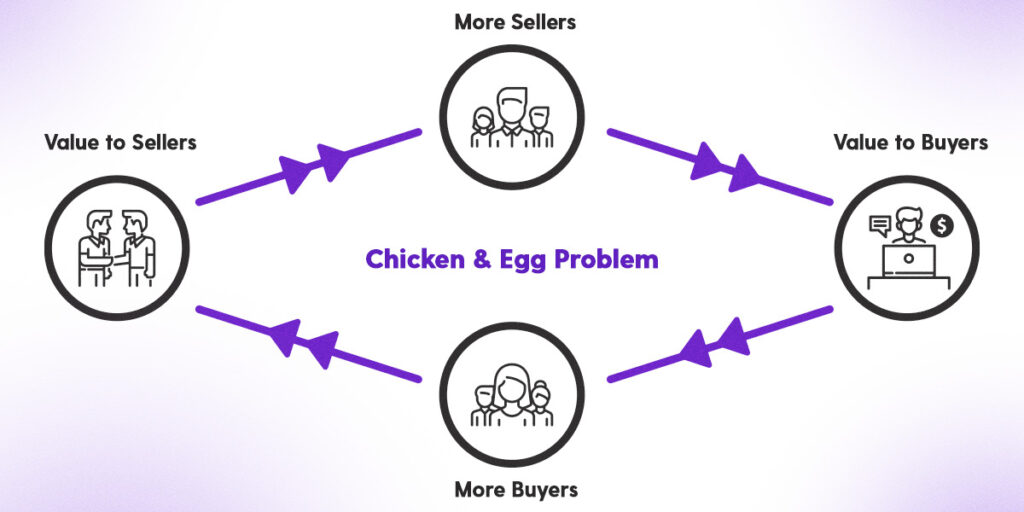
A key takeaway from this presentation is that it is best to start with the hardest side of the marketplace first. Normally speaking this is the demand side since, if you can create demand, suppliers will naturally show up to fill the demand. However, there are cases where the supply side is harder to find for example in highly specialized or niche markets where suppliers are limited.
In contrast to the approach of starting with the hardest side first, most marketplace founders default to onboarding the supply side first. This is because it tends to be easier to get the supply going by telling them that you have the potential to increase their revenue by listing on your site. However, unless you have a plan to actually generate a sustainable flow of demand, this can lead to suppliers quickly abandoning your marketplace.
Where to find early adopters
Think back to when you were doing your idea validation. At this stage, you needed to search the internet looking for potential customers to speak to about your marketplace. Your marketplace early adopters can potentially come from the same locations.
As a recap, some examples of where you can go to search for potential customers:
- Online channels e.g, Facebook groups, online forums
- Offline channels e.g. in person meetups, conferences, conventions
- B2B channels e.g. Google business, cold calling, in person visits
You might also take the approach of filling one side of the marketplace yourself to start with. This can help you learn a lot about what that side of the marketplace needs for example, potential customers or service providers.
Remember, marketplaces don’t magically take off. You have to manually recruit your customers and it is not enough to just place an ad on an advertising network.
As a disclaimer, recruiting your customers can be uncomfortable and because of this, founders often look for ways to avoid doing this. The most common way that founders look to avoid recruiting customers is to say that their product is not ready yet. They therefore spend more time behind the computer, perfecting every edge of the platform, adding new features and as a result they never launch their marketplace.
Whilst the solution is important, success of your marketplace will ultimately depend on your own ability to recruit users, listen to their feedback and continually adjust your product.
Learn and grow
Now that you have early adopters using your service marketplace, you need to watch how your customers behave when using your product. Do they hit bottlenecks? Are your customers asking you to build new features? How can you keep providing value and differentiate from your competitors?
At this stage, you need to make rapid adjustments to your platform to implement the features that your customers are asking for. This is the right time to start investing more heavily in feature development for your marketplace.
Don’t build random features. Focus on what your customers are asking for and then build those features faster than your competitors. This process of iteration is known as the build, measure learn loop. You need to build a feature that your customers are asking for, measure how the feature performs and learn from further feedback how to tune your product by improving that feature or adding the next most important feature. A graphic of this is shown below.
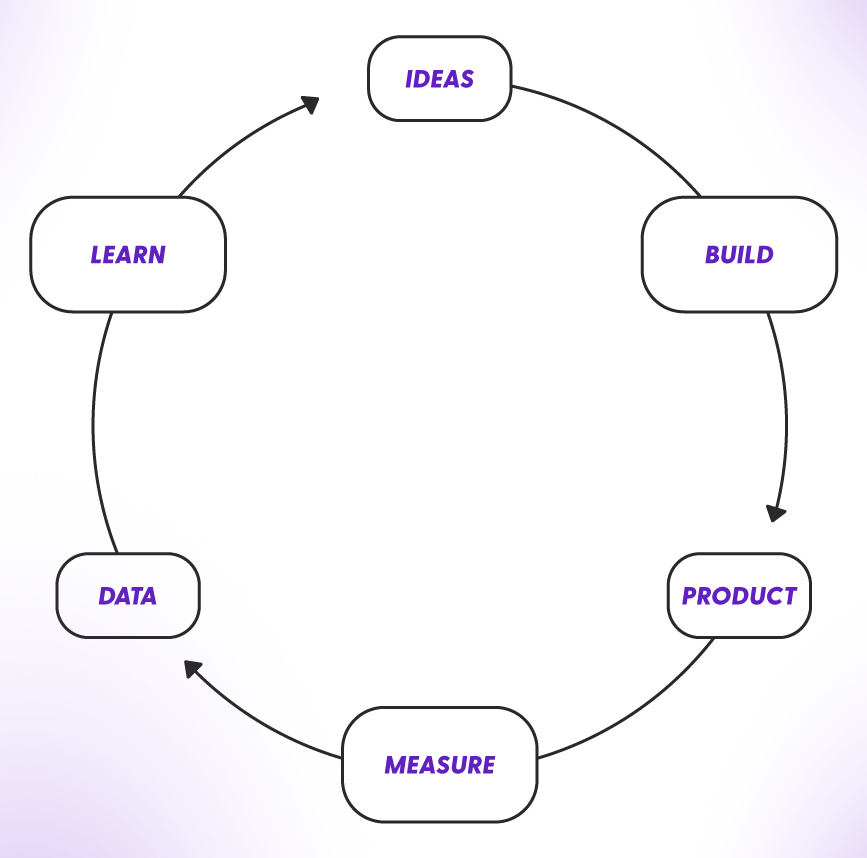
Dittofi’s visual development solution is the perfect solution for this. It gives you the flexibility to quick and easily add any new feature through our visual development studio. Unlike other marketplace builders, Dittofi was built as a hybrid no-code platform first. This means that is as flexible as coding. You can use our visual builder to quickly and easily add new features to your online marketplace without having to write any code and faster than your competitors. At every stage of your development, you can then export your code and hand it off to developers as required.
Many of our service marketplace clients choose to build integrations at this stage of their journey. For example, the marketplace may focus on developing integrations for the customer to quickly and easily list projects that they want to hire service professionals for. Nowhere was this more pronounced than with the company Cleanster who developed integrations for property managers so they could easily upload their property portfolios and cleaning schedules into Cleanster.
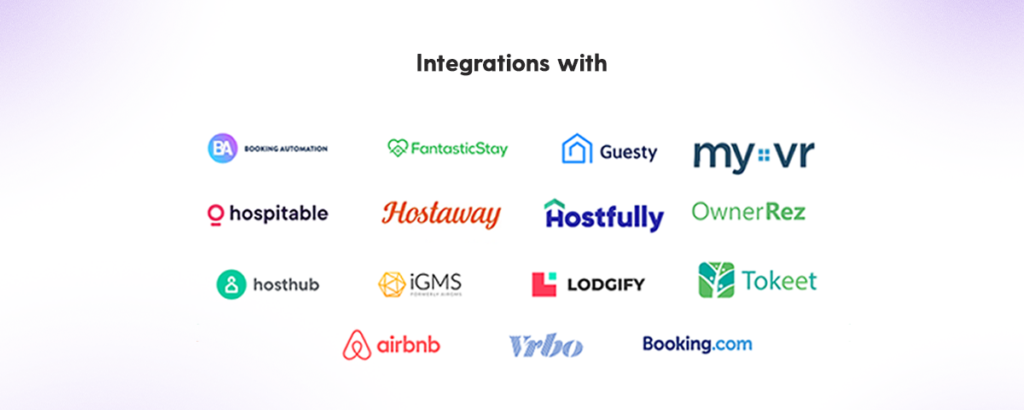
Using a visual development tool can allow you to develop features up to 10x faster when compared to traditional coding, saving you time and money but also, helping the business get closer to the product development. However, if you go this route, we recommend that you choose a hybrid no-code tool as opposed to traditional no-code or no-code marketplace builder. This is because hybrid no-code platforms come with zero vendor lock-in which means that you have granular control over the source code for your marketplace, compared to traditional no-code platforms that come with heavy limitations.
How much does it cost to build a service marketplace?
There are two main costs that you will incur during the first year of building a service marketplace business: development and marketing. In this section we break down the cost that you should expect to incur to build a successful marketplace.
Cost of service marketplace development
Service marketplaces are complicated.
Even version 1 of the marketplace, your marketplace MVP, needs to have a lot of features in it for your service providers and customers. This includes features such as your core transaction processes, administration functionality and so on.
Building such a product from scratch is expensive and time consuming.
It requires you not just to hire software developers, but also product managers, UI/UX designers, frontend developers, backend developers and infrastructure engineers. Rates for these people will vary depending on how good they are; however, if you hire a good team, you should expect to spend between $50,000 – $100,000 over 3 – 6 months, just to get started.
You should also assign a monetary value to your own work. Founder hours are important and you want to deploy your time efficiently on tasks that make sense rather than micro managing the development of your product.
Nowadays, hybrid no-code platforms like Dittofi can be used to build enterprise grade marketplaces 10x faster than traditional coding and at a significantly reduced cost.
Below is a cost comparison of building a service marketplace on Dittofi, compared to traditional coding.
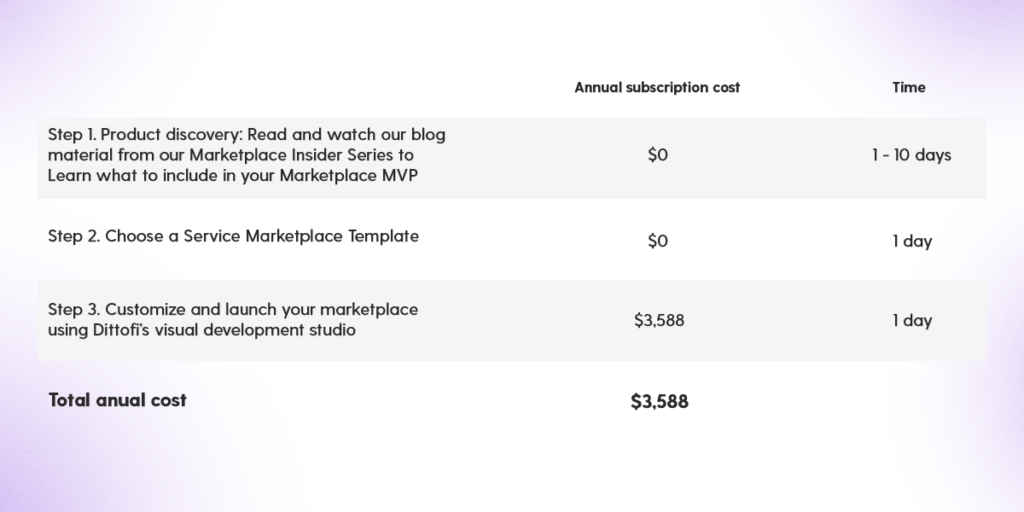
As you can see, the cost of building your marketplace with Dittofi is significantly cheaper. In addition, the quality of the solution is guaranteed by Dittofi’s auto code generators that produce enterprise grade source code to power your service marketplace.
Cost of marketing and user acquisition
In addition to development costs, you need to think about how you’re going to market your platform and attract new users. Users will come to your platform either through paid or organic (unpaid) channels. There are many different ways to market your service marketplace however, below is a rough plan and budget for what you can expect to spend on marketing.
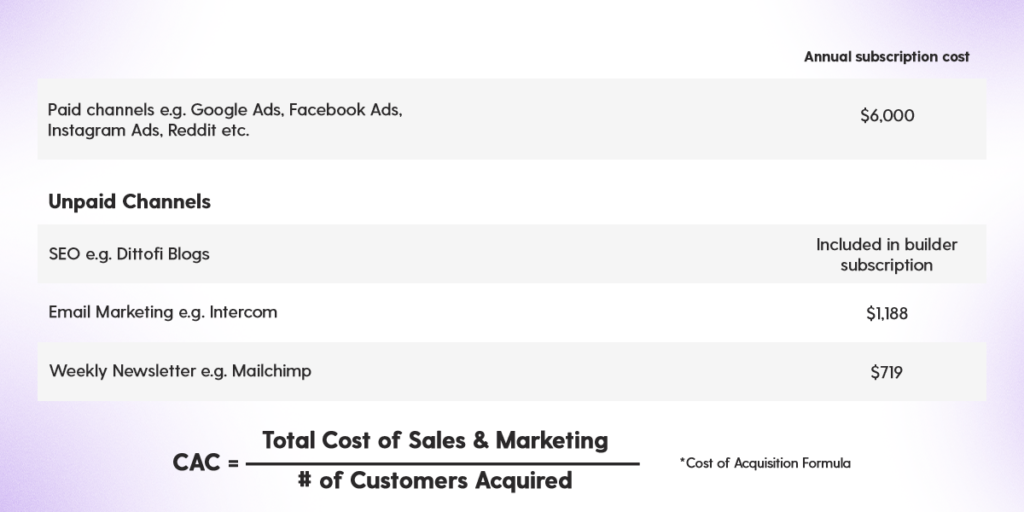
Final thoughts: Building your service marketplace business
Building a service marketplace can seem intimidating.
But don’t let this hold you back.
It is very empowering to build your own business that generates revenue. To build a successful service marketplace, you need to take it in stages and be willing to work hard to make it a success.
Remember, marketplaces don’t take off by themselves. Marketplaces take off because marketplace founders and operators make them take off.
To give yourself the best chance at success, take an iterative approach to building your service marketplace, launch early and often and remember that a good product is rarely built in isolation, but rather it is the result of collaboration between the platform creators and their clients.
A successful service marketplace requires the right business model, technology, and marketing strategy. Whether you’re launching a freelance marketplace like Upwork or a local services platform like TaskRabbit, this guide gives you a proven blueprint for success.
If you’re interested to learn more, book a call with one of our marketplace specialists for a free 45 minute consultation.
And… in case we don’t speak, we wish you the best of luck with your marketplace development!
Become a Marketplace Insider
Join our inner circle for exclusive insights, coveted trade secrets, and unparalleled strategies – your journey to marketplace dominance begins here.

